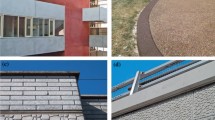Abstract
Integrated structures and materials design (ISMD) represents a new design approach that combines materials and structural engineering for the purpose of more effectively achieving targeted performance. Performance based design of structures provides flexibility and incentive to select composite materials with properties that efficiently meet the structural performance target. In this paper, ISMD concept was applied to develop pigmentable engineered cementitious composites (ECC) for architectural applications. Finite element analysis was carried out to relate structural performance (load capacity and energy absorption) to composite mechanical properties (tensile and compressive) under live and dead loads. Subsequently, white (and therefore highly pigmentable) ECC was developed to meet the desired composite properties. This paper details the structural performance—composite properties analyses, and test data on white ECC designed for the large form-factor panels. Through this research, the effectiveness of ISMD is revealed.










Similar content being viewed by others
References
Tajne KM, Thakare NU (2009) Architectural & decorative construction using coloured concrete sample. In: 2nd International conference on emerging trends in engineering and technology. Nagpur, India, pp 444–446
Li Y, Tian B (2010) Discussion on application of decorative concrete in modern architecture. In: International conference on mechanic automation and control engineering, pp 4326–4329, Wuhan
Crisman J (2006) Protective treatments for decorative concrete investments. Constr Specif 59(3):48–54
Cassar L, Pepe C, Tognon G, et al (2003) White cement for architectural concrete, possessing photocatalytic properties. In: 11th International congress on the chemistry of cement, vol 4. Durban, South Africa, pp 1–11
Mindess S, Young JF, Darwin D (2002) Concrete, 2nd edn. Pearson, Upper Saddle River
Maalej M, Hashida T, Li VC (1995) Effect of fiber volume fraction on the off-crack plane energy in strain-hardening engineered cementitious composites. J Am Ceram Soc 78(12):3369–3375
Li VC, Leung CKY (1992) Steady state and multiple cracking of short random fiber composites. ASCE J Eng Mech 118(11):2246–2264
Li VC (2007) Integrated structures and materials design. Mater Struct 40(4):387–396
Austin M (1998) Method for creating patterns in cast materials. US Patent 5,795,513, 18 Aug 1998
Stang H, Li VC (2004) Classification of fiber reinforced cementitious materials for structural applications. In: Proceedings of BEFIB. Varenna, Lake Como, Italy, pp 197–218
Li VC, Wu C, Wang S et al (2002) Interface tailoring for strain-hardening PVA-ECC. ACI Mater J 99(5):463–472
Yang EH, Yang Y, Li VC (2007) Use of high volumes of fly ash to improve ECC mechanical properties and material greenness. ACI Mater J 104(6):620–628
Acknowledgment
Support of this research by the Metamorphix Global Inc. is gratefully acknowledged.
Author information
Authors and Affiliations
Corresponding author
Rights and permissions
About this article
Cite this article
Yang, EH., Garcez, E. & Li, V.C. Development of pigmentable engineered cementitious composites for architectural elements through integrated structures and materials design. Mater Struct 45, 425–432 (2012). https://doi.org/10.1617/s11527-011-9774-1
Received:
Accepted:
Published:
Issue Date:
DOI: https://doi.org/10.1617/s11527-011-9774-1




